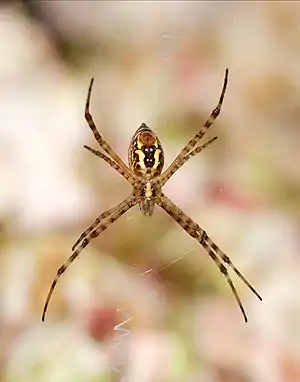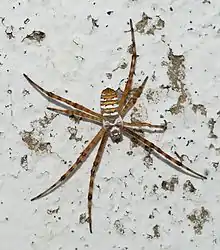Argiope trifasciata
Argiope trifasciata (the banded garden spider or banded orb weaving spider)[2] is a species of spider native to North and South America, but now found around the world.[3] It can be found in certain areas of Europe, namely the Iberian Peninsula, the Canary Islands, and Madeira.[4][2] The similar looking Argiope bruennichi is common in the Azores.[5] They typically begin to appear during autumn from early September to late October as temperatures start dropping.
| Argiope trifasciata | |
|---|---|
 | |
| female, ventral view | |
 | |
| dorsal view | |
| Scientific classification | |
| Domain: | Eukaryota |
| Kingdom: | Animalia |
| Phylum: | Arthropoda |
| Subphylum: | Chelicerata |
| Class: | Arachnida |
| Order: | Araneae |
| Infraorder: | Araneomorphae |
| Family: | Araneidae |
| Genus: | Argiope |
| Species: | A. trifasciata |
| Binomial name | |
| Argiope trifasciata | |
| Synonyms | |
|
List
| |
_-_female.jpg.webp)
Their webs can reach a diameter of about 60 cm. The length of the web depends on the size of the spider. Webs are capable of reaching a total length of two meters.
Behavior
In Illinois, Argiope trifasciata hatches in early summer but does not become readily notable until mid-August, when they have grown large enough to make their distinctive webs, which can be up to 60 cm (24 in) in diameter, among stems and bushes. The female rests at the centre of the web facing downwards, with her legs often arranged in pairs, making a cross shape; some female spiders conceal themselves in a hidden location close to the web, being alerted to a potential victim by a non-sticky thread leading to the center. Some segments of the web often have thicker threads known as stabilimenta forming a decorative pattern. Male spiders are much smaller than females and have their own small webs in close proximity to the females' webs. Argiope trifasciata is diurnal, and feeds on the insects that get snared in the web. Large, powerful prey like paper wasps, are swiftly wrapped in silk to immobilise them, before being injected with toxic saliva.[6]
Subspecies
- Argiope trifasciata deserticola Simon, 1906 (Sudan)
- Argiope trifasciata kauaiensis Simon, 1900 (Hawaii)
Web silk decorations
The silk decorations of Argiope spiders are thought of as visual signals by researchers.[7] Even though the purpose behind the silk decorations made by Argiope trifasciata remains uncertain, there are a few hypotheses: to make the spider appear larger and to act as a warning sign.[8] It has been shown that webs containing stabilimenta catch fewer insects because they are less cryptic, but on the other hand these webs are less often damaged by birds flying through them.[6]
References
- "ITIS standard report – Argiope trifasciata (Forsskål, 1775)". Integrated Taxonomic Information System. Retrieved 24 December 2015.
- "Top 20 Arachnids". Utah State University Extension Service. Archived from the original on September 17, 2018. Retrieved May 22, 2017.
- "Taxon details Argiope trifasciata (Forsskål, 1775)", World Spider Catalog, Natural History Museum Bern, retrieved 2019-11-17
- Fauna Europaea
- "Argiope bruennichi at the Azorean Biodiversity Portal". Archived from the original on 2016-03-05. Retrieved 2021-08-09.
- "Banded Garden Spider: Argiope trifasciata". North American Insects and Spiders. Retrieved 8 August 2021.
- Walter, A. (2019). "Silk decorations in Argiope spiders: Consolidation of pattern variation and specific signal function". Journal of Arachnology. 47 (2): 271–275. doi:10.1636/JoA-S-18-013. S2CID 202579185.
- Butt, A.; Alam, I. & Naz, R. (2017). "Variations in Web Architecture of Argiope trifasciata (Araneae, Araneidae) and Its Relationship with Body Parameters and Entangled Prey". Pakistan Journal of Zoology. 49 (3): 855–860. doi:10.17582/journal.pjz/2017.49.3.855.860.
External links
- "Species Argiope trifasciata – Banded Argiope". BugGuide. Retrieved August 5, 2020. With images.
- Diagnostic photographs and descriptions: Argiope trifasciata Creative Commons Licensed